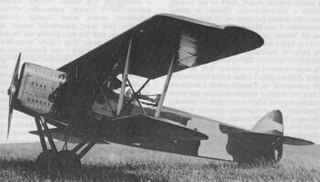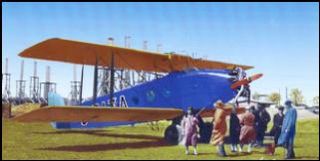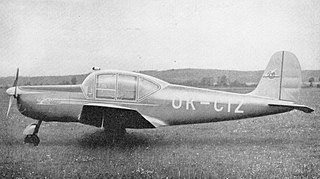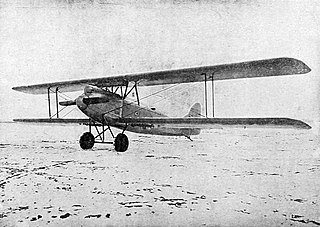
The Aero A.11 was a biplane light bomber and reconnaissance aircraft built in Czechoslovakia between the First and Second World Wars. It formed the basis for many other Czechoslovakian military aircraft of the inter-war period. Around 250 were built, with some remaining in service at the outbreak of World War II.

The Aero A.12 was a Czechoslovakian biplane light bomber and military reconnaissance aircraft manufactured in small numbers shortly after World War I. Although reminiscent of the Hansa-Brandenburg-designed aircraft that Aero was building during the war under licence as the Ae.10, the A.12 was the company's own design. It is perhaps most significant as the direct descendant of the highly successful A.11 and its various derivatives. An example of the type is preserved at the Letecké Muzeum in Kbely.

The Aero A.35 was a Czechoslovakian airliner of the 1920s and 1930s. Designed by Aero for long-range flight, with a transatlantic crossing in mind, it saw service with CSA although no such crossing was ever attempted. It first flew in 1929. A conventional high-wing monoplane, it was a very modern design for its day in all but one respect – the cockpit still had open sides. An extra passenger could also be accommodated here, beside the pilot.

The Aero A.304 was a Czechoslovakian bomber aircraft that first flew in 1937. It had originally been developed as an airliner, the A.204, but when Aero could not find buyers for the design, it was militarised and successfully marketed to the Czechoslovak Air Force.

The Walter NZ 60 was a five-cylinder, air-cooled, radial engine for aircraft use built in Czechoslovakia by Walter Aircraft Engines in the 1920s.

The Walter Venus was a seven-cylinder, air-cooled, radial engine for aircraft use, built in Czechoslovakia in the late 1920s.

The Avia BH-6 was a prototype fighter aircraft built in Czechoslovakia in 1923. It was a single-bay biplane of unusual configuration, developed in tandem with the BH-7, which shared its fuselage and tail design.

The Avia BH-8 was a prototype fighter aircraft built in Czechoslovakia in 1923. It was an unequal-span biplane developed on the basis of the ill-fated BH-6 design, in an attempt to address that type's problems. It shared the BH-6's unusual wing cellule design.
The Avia BH-19 was a fighter aircraft built in Czechoslovakia in 1924. It was a low-wing braced monoplane derived from the Avia BH-3 and reflected its designers' ongoing belief that the monoplane configuration was the most suitable for a fighter aircraft. Initial trials revealed excellent performance, but also displayed control problems and aileron flutter. Nevertheless, the Czechoslovakian Army was sufficiently impressed to inform Avia that it would order the BH-19 if the problems could be rectified. The first prototype was destroyed in a crash during speed trials, and the second prototype revealed no better handling than its predecessor. At this point, the Czechoslovakian War Ministry stepped in and asked Avia to cease its attempts to develop a monoplane fighter.

The Avia BH-22 was a trainer aircraft built in Czechoslovakia in 1925, based on the BH-21 fighter. A smaller engine was used and armament removed. The lighter engine required the wing stagger to be decreased. No significant modifications were made to the airframe structure, reduced weight further increasing the ultimate load factor. Some aeroplanes carried a camera gun. The type saw long service as a special aerobatic trainer and eventually several examples found their way into Czechoslovakia's aero clubs.

The Avia BH-23 was a prototype night fighter aircraft built in Czechoslovakia in 1926. The design was derived from the BH-21 day fighter, incorporating structural changes made to the BH-22 trainer, and the type was originally designated BH-22N. Searchlights and other night-flying equipment were added, but the Czechoslovak Air Force were not interested in the project and no sale resulted.

The Avia BH-25 was a biplane airliner built in Czechoslovakia in 1926.

The Avia BH-28 was a military reconnaissance biplane aircraft developed in Czechoslovakia in 1927 to meet a requirement for such an aircraft by the government of Romania. Avia based the design on their BH-26, but replaced the engine with an Armstrong Siddeley Jaguar, as specified in the requirement. The completed aircraft was taken to Bucharest for demonstration, but no order ensued, and this prototype was the only example constructed.

The Avia BH-29 was a trainer aircraft built in Czechoslovakia in 1927, in the hope of marketing it to both the Czechoslovakian Army, and to Czechoslovakian Airlines as a primary trainer. It was an conventional design, an unequal-span biplane of wooden construction and with tailskid undercarriage. The pilot and instructor sat in tandem open cockpits. A more powerful version was built, powered by a 120 hp (89 kW) Walter NZ-120 radial engine.

Praga E-39/BH-39 was a Czechoslovak trainer aircraft.

The Mráz M-3 Bonzo was a light aircraft built in Czechoslovakia in 1948 as a further development in the family of light aircraft that had commenced with the M-1 Sokol.

The Letov Š-6 was a bomber aircraft produced in Czechoslovakia during the 1920s. Derived from the Š-2, it was a biplane of conventional design. The wing cellule was an all-new design with a thicker profile, and while it had been intended to build them with a metal structure, wood was used instead due to shortages. Performance during testing was so promising that in 1924 an Š-6 was used to set a new altitude record with a 500 kg payload, and a national endurance record of 10 h 32 min.

The Praga BH-41, later redesignated E-41, was a military advanced trainer aircraft produced in Czechoslovakia during the 1930s.

The Praga E-51 is a Czechoslovakian reconnaissance aircraft and light bomber built by Praga in the 1930s. Development was halted by the annexation of Czechoslovakia by Germany, after only one prototype had been built. The appearance of the construction is very reminiscent of the contemporary twin engined fighter, the Fokker G.I from Holland.

The Walter NZ 85 was a seven-cylinder, air-cooled, radial engine for aircraft use built in Czechoslovakia by Walter Aircraft Engines in the late-1920s.




















